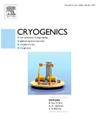Experiments and simulations related to the sudden application of a heat pulse onto a supercritical helium flow
IF 1.8
3区 工程技术
Q3 PHYSICS, APPLIED
引用次数: 0
Abstract
Vacuum loss is a major accidental scenario in cryogenic facilities that use vacuum for thermal insulation from the surrounding environment. An experimental facility, called HELIOS, has been set up to study vacuum loss around a cryoline in which supercritical helium is flowing. Before carrying out real vacuum loss experiments, a preliminary test campaign was performed using an electrical test section inserted into a cryogenic loop within the HELIOS facility, at the exact location of the future vacuum loss test section. The electrical section is equipped with an electrical heater that was used to simulate the heat pulse that would be experienced by the supercritical helium flow in the event of a real vacuum loss accident. The consequences of the abruptly applied heat pulse have been studied, both in real and simulated conditions. The main objectives of this first experimental campaign are multiple: to assess the design of the HELIOS facility, verify the accuracy of the heat flux measurement methods, and use the results of the experimental test campaigns to improve the qualification of the thermal hydraulic code employed to size the experimental setup. The simulation was based on the thermal–hydraulic code CATHARE 3 and includes two-phases cryogenic flows. Thermal-hydraulic parameters of the supercritical helium flow as pressure, temperature and mass flow rate, have been recorded for several heat loads running from 0.45 kW to 2.5 kW, with durations of up to 2 min. Heat transfer in the supercritical loop and the liquid helium bath, as well as corresponding energy balances, have been calculated. The resulting estimations of the heat applied to the test section correspond with an excellent accuracy to the real thermal loads. For a heat flux of 1.35 kW, the data were also simulated with the CATHARE 3 code. The results of the simulation match the measured and calculated data with high accuracy. This preliminary work and its associated conclusions provide a firm basis for forthcoming experiments, which will be devoted to the study of heat transfer following a real breakdown of the insulating vacuum in the supercritical helium loop.
对超临界氦流突然施加热脉冲的实验和模拟
真空损失是低温设施中使用真空与周围环境隔热的主要意外情况。一个名为HELIOS的实验设备已经建立起来,用于研究超临界氦流动的冷冻油周围的真空损失。在进行真正的真空损失实验之前,在HELIOS设备内的低温回路中插入了一个电气测试部分,在未来真空损失测试部分的确切位置进行了初步测试。电气部分配有电加热器,用于模拟在实际真空损失事故中超临界氦气流所经历的热脉冲。在实际和模拟条件下,研究了突然施加热脉冲的后果。第一次实验活动的主要目标是多重的:评估HELIOS设备的设计,验证热通量测量方法的准确性,并使用实验测试活动的结果来提高用于确定实验装置大小的热水力代码的资格。该模拟基于热工水力代码CATHARE 3,包括两相低温流。记录了在0.45 kW ~ 2.5 kW范围内持续时间为2 min的几种热负荷下,超临界氦流的热工参数,如压力、温度和质量流量。计算了超临界回路和液氦浴中的传热以及相应的能量平衡。所得到的施加在测试截面上的热的估计与实际热负荷具有极好的准确性。对于1.35 kW的热流密度,也用CATHARE 3代码进行了模拟。仿真结果与实测和计算数据吻合,精度较高。这项初步工作及其相关结论为即将进行的实验提供了坚实的基础,这些实验将致力于超临界氦回路中绝缘真空真正破裂后的传热研究。
本文章由计算机程序翻译,如有差异,请以英文原文为准。
求助全文
约1分钟内获得全文
求助全文
来源期刊

Cryogenics
物理-热力学
CiteScore
3.80
自引率
9.50%
发文量
0
审稿时长
2.1 months
期刊介绍:
Cryogenics is the world''s leading journal focusing on all aspects of cryoengineering and cryogenics. Papers published in Cryogenics cover a wide variety of subjects in low temperature engineering and research. Among the areas covered are:
- Applications of superconductivity: magnets, electronics, devices
- Superconductors and their properties
- Properties of materials: metals, alloys, composites, polymers, insulations
- New applications of cryogenic technology to processes, devices, machinery
- Refrigeration and liquefaction technology
- Thermodynamics
- Fluid properties and fluid mechanics
- Heat transfer
- Thermometry and measurement science
- Cryogenics in medicine
- Cryoelectronics
 求助内容:
求助内容: 应助结果提醒方式:
应助结果提醒方式:


